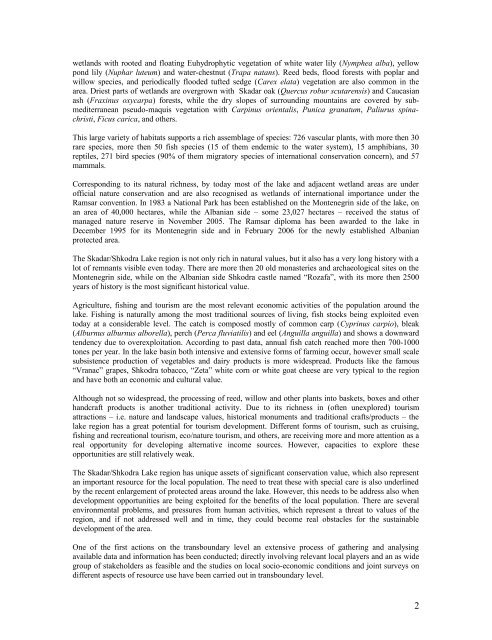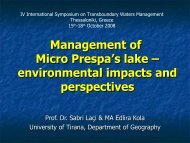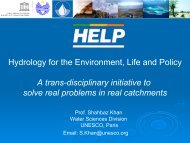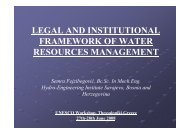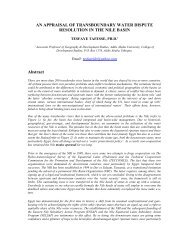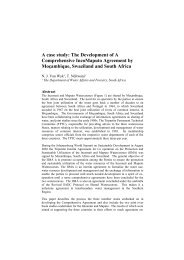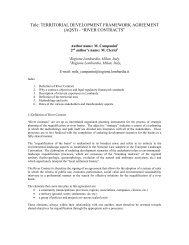transboundary cooperation through the management of ... - inweb
transboundary cooperation through the management of ... - inweb
transboundary cooperation through the management of ... - inweb
You also want an ePaper? Increase the reach of your titles
YUMPU automatically turns print PDFs into web optimized ePapers that Google loves.
wetlands with rooted and floating Euhydrophytic vegetation <strong>of</strong> white water lily (Nymphea alba), yellow<br />
pond lily (Nuphar luteum) and water-chestnut (Trapa natans). Reed beds, flood forests with poplar and<br />
willow species, and periodically flooded tufted sedge (Carex elata) vegetation are also common in <strong>the</strong><br />
area. Driest parts <strong>of</strong> wetlands are overgrown with Skadar oak (Quercus robur scutarensis) and Caucasian<br />
ash (Fraxinus oxycarpa) forests, while <strong>the</strong> dry slopes <strong>of</strong> surrounding mountains are covered by submediterranean<br />
pseudo-maquis vegetation with Carpinus orientalis, Punica granatum, Paliurus spinachristi,<br />
Ficus carica, and o<strong>the</strong>rs.<br />
This large variety <strong>of</strong> habitats supports a rich assemblage <strong>of</strong> species: 726 vascular plants, with more <strong>the</strong>n 30<br />
rare species, more <strong>the</strong>n 50 fish species (15 <strong>of</strong> <strong>the</strong>m endemic to <strong>the</strong> water system), 15 amphibians, 30<br />
reptiles, 271 bird species (90% <strong>of</strong> <strong>the</strong>m migratory species <strong>of</strong> international conservation concern), and 57<br />
mammals.<br />
Corresponding to its natural richness, by today most <strong>of</strong> <strong>the</strong> lake and adjacent wetland areas are under<br />
<strong>of</strong>ficial nature conservation and are also recognised as wetlands <strong>of</strong> international importance under <strong>the</strong><br />
Ramsar convention. In 1983 a National Park has been established on <strong>the</strong> Montenegrin side <strong>of</strong> <strong>the</strong> lake, on<br />
an area <strong>of</strong> 40,000 hectares, while <strong>the</strong> Albanian side – some 23,027 hectares – received <strong>the</strong> status <strong>of</strong><br />
managed nature reserve in November 2005. The Ramsar diploma has been awarded to <strong>the</strong> lake in<br />
December 1995 for its Montenegrin side and in February 2006 for <strong>the</strong> newly established Albanian<br />
protected area.<br />
The Skadar/Shkodra Lake region is not only rich in natural values, but it also has a very long history with a<br />
lot <strong>of</strong> remnants visible even today. There are more <strong>the</strong>n 20 old monasteries and archaeological sites on <strong>the</strong><br />
Montenegrin side, while on <strong>the</strong> Albanian side Shkodra castle named “Rozafa”, with its more <strong>the</strong>n 2500<br />
years <strong>of</strong> history is <strong>the</strong> most significant historical value.<br />
Agriculture, fishing and tourism are <strong>the</strong> most relevant economic activities <strong>of</strong> <strong>the</strong> population around <strong>the</strong><br />
lake. Fishing is naturally among <strong>the</strong> most traditional sources <strong>of</strong> living, fish stocks being exploited even<br />
today at a considerable level. The catch is composed mostly <strong>of</strong> common carp (Cyprinus carpio), bleak<br />
(Alburnus alburnus alborella), perch (Perca fluviatilis) and eel (Anguilla anguilla) and shows a downward<br />
tendency due to overexploitation. According to past data, annual fish catch reached more <strong>the</strong>n 700-1000<br />
tones per year. In <strong>the</strong> lake basin both intensive and extensive forms <strong>of</strong> farming occur, however small scale<br />
subsistence production <strong>of</strong> vegetables and dairy products is more widespread. Products like <strong>the</strong> famous<br />
“Vranac” grapes, Shkodra tobacco, “Zeta” white corn or white goat cheese are very typical to <strong>the</strong> region<br />
and have both an economic and cultural value.<br />
Although not so widespread, <strong>the</strong> processing <strong>of</strong> reed, willow and o<strong>the</strong>r plants into baskets, boxes and o<strong>the</strong>r<br />
handcraft products is ano<strong>the</strong>r traditional activity. Due to its richness in (<strong>of</strong>ten unexplored) tourism<br />
attractions – i.e. nature and landscape values, historical monuments and traditional crafts/products – <strong>the</strong><br />
lake region has a great potential for tourism development. Different forms <strong>of</strong> tourism, such as cruising,<br />
fishing and recreational tourism, eco/nature tourism, and o<strong>the</strong>rs, are receiving more and more attention as a<br />
real opportunity for developing alternative income sources. However, capacities to explore <strong>the</strong>se<br />
opportunities are still relatively weak.<br />
The Skadar/Shkodra Lake region has unique assets <strong>of</strong> significant conservation value, which also represent<br />
an important resource for <strong>the</strong> local population. The need to treat <strong>the</strong>se with special care is also underlined<br />
by <strong>the</strong> recent enlargement <strong>of</strong> protected areas around <strong>the</strong> lake. However, this needs to be address also when<br />
development opportunities are being exploited for <strong>the</strong> benefits <strong>of</strong> <strong>the</strong> local population. There are several<br />
environmental problems, and pressures from human activities, which represent a threat to values <strong>of</strong> <strong>the</strong><br />
region, and if not addressed well and in time, <strong>the</strong>y could become real obstacles for <strong>the</strong> sustainable<br />
development <strong>of</strong> <strong>the</strong> area.<br />
One <strong>of</strong> <strong>the</strong> first actions on <strong>the</strong> <strong>transboundary</strong> level an extensive process <strong>of</strong> ga<strong>the</strong>ring and analysing<br />
available data and information has been conducted; directly involving relevant local players and an as wide<br />
group <strong>of</strong> stakeholders as feasible and <strong>the</strong> studies on local socio-economic conditions and joint surveys on<br />
different aspects <strong>of</strong> resource use have been carried out in <strong>transboundary</strong> level.<br />
2


